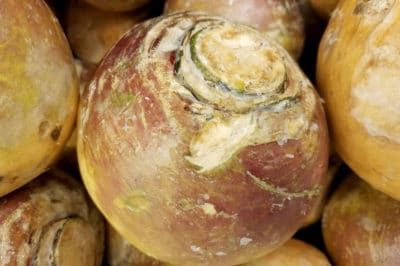Storing Rutabagas in the Ground
If you planted your rutabagas in midsummer for harvesting in the fall and winter, you can leave your rutabagas where they’re planted until temperatures are about to drop below 20°F (7°C) and cause the ground to freeze over, just as you can with shallots. Simply cover the area above your rutabagas and 18 inches beyond it with 2 feet of straw, hay, or leaves. Leaving your rutabagas in the ground takes advantage of frosts that further sweeten their taste.
Preparing Your Rutabagas for Storage After Harvesting
When the temperatures fall and you must harvest the rutabagas still in the ground, you will need to prepare them for storage in your freezer, in your refrigerator, in a partially buried barrel or crate, or in a root cellar.
To prepare your rutabagas, brush the soil from them, but don’t wash or rinse them or even wipe them with a damp rag. Getting them wet in any way provides mold and mildew spores with an opportunity to grow and ruin your crop.
Next, cut off the tap root from where it extends below the rutabaga, and cut off the leaves, leaving an inch of stem at the top of the rutabaga. You can use the leaves in salads, stews, or soups.
After preparing your rutabagas for storage, you should cool them as quickly as possible to prevent dehydration, but if you plan on storing your rutabagas in your refrigerator, consider melting paraffin and dipping them in the warm wax before placing them in storage.
You’ll find rutabagas at grocery stores and farmer’s markets sporting this wax coating because it helps the rutabaga retain moisture and avoid drying out.
Your refrigerator will maintain the proper temperature for storing rutabagas, which is between 32°F and 35°F (0°C-2°C), but it doesn’t maintain the high level of humidity rutabagas require, which is between 90 and 95 percent.
Storing Rutabagas in a Root Cellar
A root cellar will maintain the temperature and humidity level that rutabagas need. If you have one, all you need to do is place your rutabagas in boxes between layers of straw, peat moss, or sand, and move the boxes to your root cellar. Check periodically to make sure that the boxes aren’t sitting in water and that you don’t have any rutabagas that are spoiling. Remove any spoiled rutabagas, and if one or more boxes are sitting in water, pack the rutabagas in a new, dry box. Your should be able to store your rutabagas in a root cellar for 4 to 6 months.
Storing Rutabagas in Partially Buried Barrels and Crates
If you don’t have a root cellar, a partially buried barrel or crate can serve as a substitute. You just need to make sure that your rutabagas are well cushioned and insulated, and that they have a sufficient amount of air flowing around them.
Start by placing a layer of moist peat moss or sand in the bottom of your barrel or crate. Place your rutabagas on top of that layer with space between them for air to circulate. Finally, cover your rutabagas with a layer of burlap sacks that you have filled with more sand or moist peat moss.
To be certain that your rutabagas aren’t exposed to light while you are storing them, bury your barrel or crate almost completely underground, leaving just an opening above ground.
As with a root cellar, you should be able to keep your rutabagas in a partially buried crate or barrel for 4 to 6 months.
Storing Your Rutabagas in Your Refrigerator
To store your rutabagas in your refrigerator, wrap them in a moist paper towel or cloth and place them in paper bags punched with holes. You can punch the holes yourself with a hole punch, spacing them 1 inch apart. Place the bagged rutabagas in your crisper drawer. You can store rutabagas in your refrigerator for about one month.
Storing Your Rutabagas in Your Freezer
You will need to prepare your rutabagas for storage in your freezer by dicing and blanching them. You can use the same process for freezing turnips[/link.
- Place cold water in a large pot, and bring the water to a boil on your range or cooktop.
- While you wait for the water to boil, peel your rutabagas as you would before cooking them and dice them into large cubes.
- Put the diced rutabaga cubes in the boiling water and blanche them for 3 minutes.
- Immediately after blanching, plunge your rutabaga cubes into ice water to cool for 3 minutes.
After the cubes have cooled, you can place them in freezer bags or containers as is, or you can mash them before placing them in the freezer containers. Remove as much air as you possibly can from the bags.
Place the bags or containers in the deepest part of a chest freezer or against the walls and to the back of the shelves in an upright freezer so that your rutabaga freezes as rapidly as possible. After your rutabaga is thoroughly frozen, you can rearrange the containers to create freezing and storage space for other foods.
